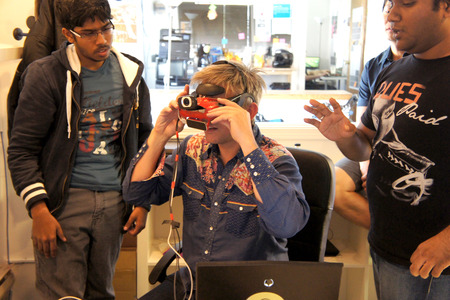Experimental headsets are changing how we see the world, either by creating the virtual worlds of our imaginations, like the Oculus Rift, or adding ghostly layers on top of the real world, like Google Glass. At the LEAP.AXLR8R, GetVu’s vision lies between these two extremes – an augmented reality platform where 3D models appear to exist in real space, amongst real objects.
At the same time, GetVu wants to bring a new level of control to augmented reality with Leap Motion technology. Instead of using voice controls to indirectly interact with a virtual object, you could reach out and move it around with your hands. Architectural models standing in real cities, tabletop games, ancient ruins brought to life – the possibilities for developers and users alike are endless.

The GetVu team getting feedback from Philip Rosedale, creator of Second Life.
GetVu is a team of three computer science and engineering students from India – programmers Santhosh and Sundar, and designer Rakesh. After experimenting with a GetVu glass prototype and the Leap Motion Controller, they travelled to San Francisco to join us here at the LEAP.AXLR8R. We recently asked Rakesh about his team’s quest:
Augmented reality today is working with a 3D object in a 2D screen, and you get to interact with it by means of a touch screen or a virtual button. We found the Leap Motion Controller and started taping it together with our raw prototype. With it, we achieved natural interaction with an AR application using our hands.
Accuracy is the key here. If there is no accuracy, people get irritated with the applications. Leap Motion has given us a way where you can interact with applications in the most natural way possible.
Unlike other AR headsets that use translucent holographic displays, GetVu’s technology allows for fully realized 3D models that you can’t see through. On the hardware front, since the existing GetVu prototype is built on the Android platform, you can slide an Android phone into the headset and connect it to the Leap Motion Controller.
GetVu is also designed to be universal. Instead of studying a new SDK and developing applications specifically for the hardware, developers will be able to start building with the SDK of their choice. The current version of GetVu’s software is already integrated with Vuforia, one of the top AR app software platforms. Rakesh says that GetVu’s next step is to make all the top existing AR SDKs available for the headset, while continuing to refine the embedded hardware:
Augmented reality with motion controls will give rise to a world of applications which will allow you to touch and almost feel the virtual world. Working with the AXLR8R has been an amazing experience so far – we feel it’s been a huge leap for our company, and for the future of AR.
Arvind Gupta is the founder of the LEAP.AXLR8R and partner at SOSventures. This post originally appeared on the LEAP.AXLR8R blog.

[…] JavaScript, keyboard, music, oculus rift, software, sxsw, vimeo Previous PostLook and Reach into Another Layer of Reality […]
April 22, 2014 at 2:25 pm